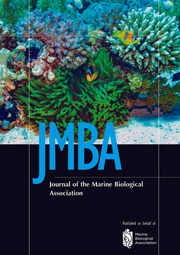Spatial patterns and seasonality in the epibenthic communities of the Westerschelde (Southern Bight of the North Sea)
Published online by Cambridge University Press: 01 February 2000
Abstract
Beamtrawl samples were taken monthly between January 1988 and December 1989 in 14 subtidal stations along the longitudinal axis of the Westerschelde Estuary. The estuary harboured high densities of epibenthic species (total average of 2250 ind 1000 m−2). Only 37 fish species were recorded and three mobile macroinvertebrate species were quantified. Seventeen epibenthic species were common, only eight of which were very abundant. An overall dominance of the brown shrimp Crangon crangon was noted. The near absence of anadromous and freshwater species was correlated with the low oxygen concentrations upstream the Dutch–Belgian border. The epibenthic species could be divided into a polyhaline and a mesohaline community along the main salinity–oxygen–turbidity gradients of the estuary. The mesohaline zone was characterized by higher densities and biomasses for shrimps, gobies and flatfish. The spatial structure in the epibenthic community of the polyhaline zone was more influenced by the watermasses from the sea and inflowing channels, and was correlated with the degree of exposure (current velocities and tides). A classification is proposed, based on the season in which the epibenthic species occur in the estuary, and on their life stages and abundances during that period. The monthly data demonstrate that while the eight abundant epibenthic species were generally present throughout the year (summer or winter resident), the majority tended to appear in the Westerschelde at varying times (summer, winter or bimodal) and often remained in large numbers (nine common species) for only a short time. The fact that mainly juveniles were recorded in the higher density-classes, suggests that the Westerschelde Estuary still acts as a nursery area for many epibenthic species.
- Type
- Research Article
- Information
- Journal of the Marine Biological Association of the United Kingdom , Volume 80 , Issue 1 , February 2000 , pp. 27 - 36
- Copyright
- © 2000 Marine Biological Association of the United Kingdom
- 13
- Cited by




